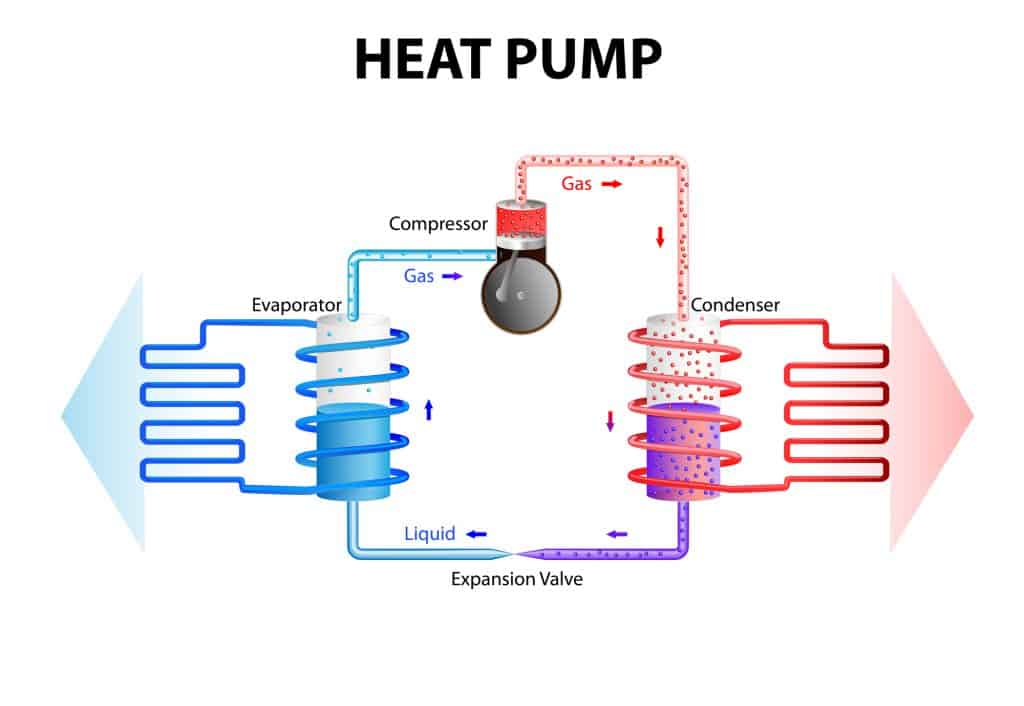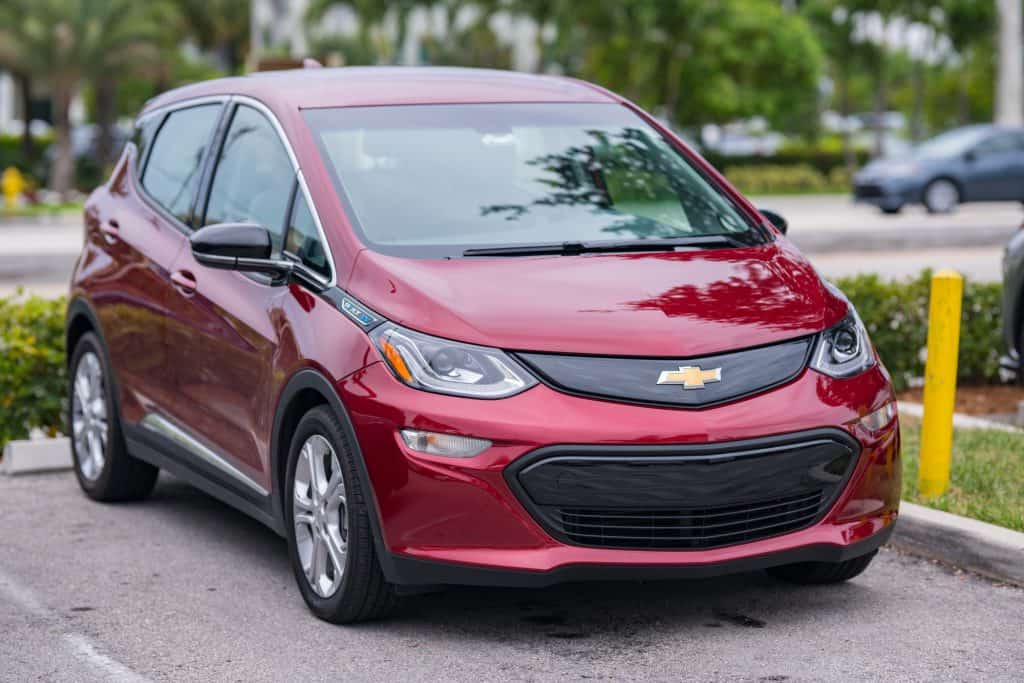The Chevrolet Bolt has proven itself to be one of the most popular electric vehicles on the market, selling more than 100,000 units globally since it was first launched. That number may sound low compared to gasoline cars on the market, but don’t forget that electric cars still represent a tiny fraction of the overall marketplace and are still relatively new in the hearts and minds of most drivers.
One of the improvements that has been added to certain electric cars in recent years has been a new heating and cooling system in the form of the “heat pump.” The Chevy Bolt has been around since 2017, and some owners might be wondering if their Bolt was lucky enough to receive the heat pump upgrade. Does your Chevy Bolt have a heat pump? That’s the central question of today’s blog.
First of all, let’s get some background on what exactly a heat pump is.
Background: What is a Heat Pump?
A heat pump is an alternative to the widely used resistance heaters that are currently used to heat electric vehicles. They are touted as the best new option for EVs because they don’t rely on electrical supply as resistance heaters do and will therefore not be as big a drain on the battery pack. In fact, there’s much to support the idea that heat pumps can actually be a part of significantly increasing the range of EVs in the future.
How Does a Heat Pump Work?
A heat pump uses ambient air to generate large amounts of heat with relatively small amounts of electrical energy. The idea is that by saving battery energy that would normally be greatly wasted on resistance heaters, heat pumps can be used instead to extend range and battery life.

Air enters via an external heat exchanger and then passes through an electric compressor and gas injector, which heats it. This air then passes to the inner condensers after which it can be sent into the cabin as warm air. The air is circulated, with some passing back out through the heat exchanger, but other air being passed again through the compressor.
One of the main problems heat pump technology had in its early stages was over reliance on a fairly mild ambient temperature, or at least not a long way below freezing. The colder the ambient air was, the less effective the process could be.
This has since been improved with the innovation of new heat pump systems that can extract high-density vapor and inject it into the compressor. This boosts heating performance in the colder weather, and places the heat pump closer alongside gasoline car heating systems in terms of effectiveness and reliability.
Tesla also came up with a solution for its Model Y — the first Tesla to get the heat pump technology — where in colder conditions where the ambient temperature was dropping below a certain level, the heat pump would switch to drawing heat from one of the motors. One motor would switch to free spinning mode, thus generating heat to be pumped.
Why does an EV even need such a different system? Can’t they just generate heat the same way that most cars do? This is the heart of the problem. A conventional internal combustion car that uses gasoline or diesel, generates a great amount of heat in the engine bay. In these cars, this heat is simply channeled through to the cabin to create a warm blast of air that will continue as long as the engine is active. An electric vehicle cannot do this.
The electric vehicle has one critical component missing — the internal combustion engine. With no engine there’s no heat source and therefore no hot air to channel into the passenger cabin. This is why they have largely relied on resistance heaters.
This is probably among the lowest-tech items in the entire EV, with electrical resistance heating tracing its origin back to the late 19th century. Can you imagine something from the 19th century being in a Tesla or Chevrolet Bolt?
Because electrical resistance heating uses a lot of energy and is wasteful, the heat pump has been developed as a viable alternative.
Does My Chevy Bolt Have a Heat Pump?

Now we come to the somewhat bad news for Chevy Bolt owners: which is that there are still no heat pumps in the Chevrolet Bolt. Though there has been a lot of talk and a lot of speculation about such an addition, the fact remains that even in the all-new 2022 Chevy Bolt EUV crossover, no heat pump is offered as an option.
This is both surprising and frustrating to many Chevy Bolt owners and fans because even back in 2018, insideevs.com did a piece in which they reported it was strongly hinted by Chevrolet that they were actively considering adding the heat pump to future models. The survey was carried out in late 2018, which would have made it arguably feasible for a heat pump addition to be unveiled in 2019 for the 2020 model. Alas, it never came.
The same survey hinted at an entire winter weather package that would have included:
- Radiant floor heating
- Wiper parking heater
- Heat pump
- Cold weather battery pack
- Heated front windshield
Though improvements have been added, especially to the new Bolt EUV which is going to be the first model to get Chevy’s Super Cruise semi autonomous driving technology, it seems that the heat pump is not one of them.
Alternatives to the Heat Pump
What should current or aspiring Bolt owners do? Should they just continue to sacrifice battery power for continued resistance heating? Should they petition Chevrolet to add the winter package with all of the above on it, after all? Perhaps the better question is, what can they do?
First of all, Bolt drivers in cold climates probably shouldn’t despair, and here’s why. Further above in the blog we mentioned improvements to technology that could make heat pumps more effective in very cold weather.
The problem here is that there’s no guarantee that any Chevrolet heat pump would make use of the technology. The company relies on the competitive price of the Bolt in order to secure its market position against the competition. To install such an elaborate heat pump would inevitably cost more.
Therefore, the resistance heating system is quite a happy alternative to the heat pump for now, allowing you to get effective, reliable heat no matter how low the temperature is outside.
Users of the earlier Leaf models that featured heat pumps did not have a great amount of good things to say about it when temperatures hit rock bottom. As the temperature drops, so does its efficiency.

At its best it can be 300% efficient, creating for instance 2250W of heat for just 750W of power used, but when the temperature is low that number can easily drop below 100% meaning that it couldn’t even get 750W of heat out for 750W of power used.
Conclusion: Is the Heat Pump Worth It?
If the heat pump can be made into a truly viable low-temperature alternative that is easily applied to EVs, then there’s no reason at all that a Bolt couldn’t or shouldn’t have the heat pump in the future.
The main thing to realize is that a heat pump is not yet the be-all and end-all of EV heating systems. It’s certainly a step in the right direction, but can we blame Chevrolet for not employing the technology before it has had a chance to mature and become more efficient?